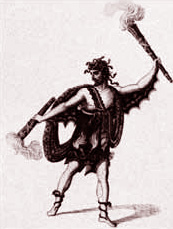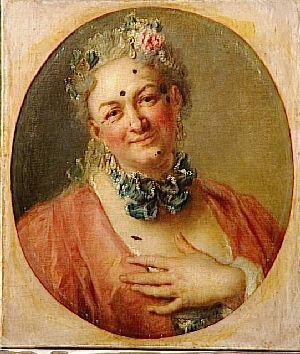|
Iphigénie En Tauride (Desmarets And Campra)
''Iphigénie en Tauride'' (English: ''Iphigeneia in Tauris'') is an opera by the French composers Henri Desmarets and André Campra. It takes the form of a ''tragédie en musique'' in a prologue and five acts. The libretto is by Joseph-François Duché de Vancy with additions by Antoine Danchet. Desmarets had begun work on the opera around 1696 but abandoned it when he was forced to go into exile in 1699. Campra and his regular librettist Danchet took up the piece and wrote the prologue, most of Act Five, two arias in Act One, an aria for Acts Two and Three, and two arias for the fourth act. The plot is ultimately based on Euripides' tragedy ''Iphigeneia in Tauris''. Performance history ''Iphigénie'' was first performed by the Académie royale de musique at the Théâtre du Palais-Royal in Paris on 6 May 1704 with Françoise Journet as Iphigénie and Gabriel-Vincent Thévenard Gabriel-Vincent Thévenard (10 August 1669 – 24 August 1741) was a French operatic baritone (''b ... [...More Info...] [...Related Items...] OR: [Wikipedia] [Google] [Baidu] |
Christoph Willibald Gluck
Christoph Willibald (Ritter von) Gluck (; 2 July 1714 – 15 November 1787) was a composer of Italian and French opera in the early classical period. Born in the Upper Palatinate and raised in Bohemia, both part of the Holy Roman Empire, he gained prominence at the Habsburg court at Vienna. There he brought about the practical reform of opera's dramaturgical practices for which many intellectuals had been campaigning. With a series of radical new works in the 1760s, among them '' Orfeo ed Euridice'' and '' Alceste'', he broke the stranglehold that Metastasian '' opera seria'' had enjoyed for much of the century. Gluck introduced more drama by using orchestral recitative and cutting the usually long da capo aria. His later operas have half the length of a typical baroque opera. Future composers like Mozart, Schubert, Berlioz and Wagner revered Gluck very highly. The strong influence of French opera encouraged Gluck to move to Paris in November 1773. Fusing the traditions ... [...More Info...] [...Related Items...] OR: [Wikipedia] [Google] [Baidu] |
Operas By Multiple Composers
Opera is a form of theatre in which music is a fundamental component and dramatic roles are taken by singers. Such a "work" (the literal translation of the Italian word "opera") is typically a collaboration between a composer and a librettist and incorporates a number of the performing arts, such as acting, scenery, costume, and sometimes dance or ballet. The performance is typically given in an opera house, accompanied by an orchestra or smaller musical ensemble, which since the early 19th century has been led by a conductor. Although musical theatre is closely related to opera, the two are considered to be distinct from one another. Opera is a key part of the Western classical music tradition. Originally understood as an entirely sung piece, in contrast to a play with songs, opera has come to include numerous genres, including some that include spoken dialogue such as ''Singspiel'' and ''Opéra comique''. In traditional number opera, singers employ two styles of singing: ... [...More Info...] [...Related Items...] OR: [Wikipedia] [Google] [Baidu] |
Jean Dun
Jean Dun, also known as Jean Dun "père", (? – 1735) was a French opera singer active at the Paris Opéra where he created many bass roles during the late 17th and early 18th centuries. He was also the bass soloist at the church of Saint-Paul-Saint-Louis in Paris during the time Charpentier was the Master of Music there. His voice is described in contemporary sources as ''basse-taille'', which is closer in quality to that of a modern baritone. Little is known about his early life, but according to Casaglia, he appeared in the small role of Eutyro in the premiere of Francesco Cavalli's ''Ercole amante'' in 1662.Casaglia (2005) By 1697, he was singing leading roles, sometimes creating as many as two or three in one opera, e.g. in the 1710 premiere of André Campra's opéra-ballet ''Les fêtes vénitiennes''. In the course of his lengthy career he appeared in more than 37 operas.Antony (2008) p. 34. Dun retired from the stage in 1720 with a pension from the Paris Opéra, but from 1 ... [...More Info...] [...Related Items...] OR: [Wikipedia] [Google] [Baidu] |
Alto Clef
A clef (from French: 'key') is a musical symbol used to indicate which notes are represented by the lines and spaces on a musical stave. Placing a clef on a stave assigns a particular pitch to one of the five lines, which defines the pitches on the remaining lines and spaces. The three clef symbols used in modern music notation are the G-clef, F-clef, and C-clef. Placing these clefs on a line fixes a reference note to that line—an F-clef fixes the F below middle C, a C-clef fixes middle C, and a G-clef fixes the G above middle C. In modern music notation, the G-clef is most frequently seen as treble clef (placing G4 on the second line of the stave), and the F-clef as bass clef (placing F3 on the fourth line). The C-clef is mostly encountered as alto clef (placing middle C on the third line) or tenor clef (middle C on the fourth line). A clef may be placed on a space instead of a line, but this is rare. The use of different clefs makes it possible to write music for ... [...More Info...] [...Related Items...] OR: [Wikipedia] [Google] [Baidu] |
Baritenor
Baritenor (also rendered in English language sources as bari-tenor or baritenore) is a portmanteau (blend) of the words "baritone" and "tenor." It is used to describe both baritone and tenor voices. In ''Webster's Third New International Dictionary'' it is defined as "a baritone singing voice with virtually a tenor range." However, the term was defined in several late 19th century and early 20th century music dictionaries, such as ''The American History and Encyclopedia of Music'', as "a low tenor voice, almost barytone sic.html"_;"title="'sic">'sic''" _In_opera Baritenor_(or_its_Italian_language.html" "title="sic">'sic''.html" ;"title="sic.html" ;"title="'sic">'sic''">sic.html" ;"title="'sic">'sic''" In opera Baritenor (or its Italian language">Italian form, ''baritenore'') is still used today to describe a type of tenor voice which came to particular prominence in Rossini's operas. It is characterized by a dark, weighty lower octave and a ringing upper one but with sufficient ... [...More Info...] [...Related Items...] OR: [Wikipedia] [Google] [Baidu] |
Académie Royale De Musique
The Paris Opera (, ) is the primary opera and ballet company of France. It was founded in 1669 by Louis XIV as the , and shortly thereafter was placed under the leadership of Jean-Baptiste Lully and officially renamed the , but continued to be known more simply as the . Classical ballet as it is known today arose within the Paris Opera as the Paris Opera Ballet and has remained an integral and important part of the company. Currently called the , it mainly produces operas at its modern 2,723-seat theatre Opéra Bastille which opened in 1989, and ballets and some classical operas at the older 1,979-seat Palais Garnier which opened in 1875. Small scale and contemporary works are also staged in the 500-seat Amphitheatre under the Opéra Bastille. The company's annual budget is in the order of 200 million euros, of which €100M come from the French state and €70M from box office receipts. With this money, the company runs the two houses and supports a large permanent staff, ... [...More Info...] [...Related Items...] OR: [Wikipedia] [Google] [Baidu] |
Haute-contre
The haute-contre (plural hautes-contre) was the primary French operatic tenor voice, predominant in French Baroque and Classical opera, from the middle of the seventeenth century until the latter part of the eighteenth century. History This voice was predominantly used in male solo roles, typically heroic and amatory ones, but also in comic parts, even ''en travesti'' (see apropos the portrait reproduced below and representing Pierre Jélyotte made up for the female title role of Rameau's ''Platée''). Lully wrote 8 out of 14 leading male roles for the voice; Charpentier, who was an haute-contre himself, composed extensively for the voice-part, as did Rameau and, later, Gluck. The leading ''hautes-contre'' of the ''Académie Royale de Musique'' that created the main roles of Lully's operas, at the end of the seventeenth century, were Bernard Clédière (who started off as a ''taille'', a lower Tenor voice type) and Louis Gaulard Dumesny. Notable ''hautes-contre'' of the eighteent ... [...More Info...] [...Related Items...] OR: [Wikipedia] [Google] [Baidu] |
Contralto
A contralto () is a type of classical female singing voice whose vocal range is the lowest female voice type. The contralto's vocal range is fairly rare; similar to the mezzo-soprano, and almost identical to that of a countertenor, typically between the F below middle C (F3 in scientific pitch notation) to the second F above middle C (F5), although, at the extremes, some voices can reach the D below middle C (D3) or the second B above middle C (B5). The contralto voice type is generally divided into the coloratura, lyric, and dramatic contralto. History "Contralto" is primarily meaningful only in reference to classical and operatic singing, as other traditions lack a comparable system of vocal categorization. The term "contralto" is only applied to female singers; men singing in a similar range are called "countertenors". The Italian terms "contralto" and "alto" are not synonymous, "alto" technically denoting a specific vocal range in choral singing without regard to factors ... [...More Info...] [...Related Items...] OR: [Wikipedia] [Google] [Baidu] |
Mezzo-soprano
A mezzo-soprano or mezzo (; ; meaning "half soprano") is a type of classical female singing voice whose vocal range lies between the soprano and the contralto voice types. The mezzo-soprano's vocal range usually extends from the A below middle C to the A two octaves above (i.e. A3–A5 in scientific pitch notation, where middle C = C4; 220–880 Hz). In the lower and upper extremes, some mezzo-sopranos may extend down to the F below middle C (F3, 175 Hz) and as high as "high C" (C6, 1047 Hz). The mezzo-soprano voice type is generally divided into the coloratura, lyric, and dramatic mezzo-soprano. History While mezzo-sopranos typically sing secondary roles in operas, notable exceptions include the title role in Bizet's '' Carmen'', Angelina (Cinderella) in Rossini's ''La Cenerentola'', and Rosina in Rossini's ''Barber of Seville'' (all of which are also sung by sopranos and contraltos). Many 19th-century French-language operas give the leading female role to mezzos, includin ... [...More Info...] [...Related Items...] OR: [Wikipedia] [Google] [Baidu] |
Julie D'Aubigny
Julie d'Aubigny (; 1673–1707), better known as Mademoiselle Maupin or La Maupin, was a French opera singer. Little is known for certain about her life; her tumultuous career and flamboyant lifestyle were the subject of gossip, rumour, and colourful stories in her own time, and inspired numerous fictional and semi-fictional portrayals afterwards. Her life loosely inspired the titular character of Théophile Gautier's 1835 novel, ''Mademoiselle de Maupin,'' in which she employs multiple disguises to seduce a young man and his mistress. Due to her relationships with men and women, some modern-day sources refer to d'Aubigny as bisexual and/or queer. Early life Julie d'Aubigny was born in 1673 pp. 350-352 archive.org/ref> to Gaston d'Aubigny, a secretary to Louis de Lorraine-Guise, comte d'Armagnac, the Master of the Horse for King Louis XIV. Her father, who trained the court pages, took care of her education teaching her academic subjects of the type given to boys but also tr ... [...More Info...] [...Related Items...] OR: [Wikipedia] [Google] [Baidu] |







.jpg)